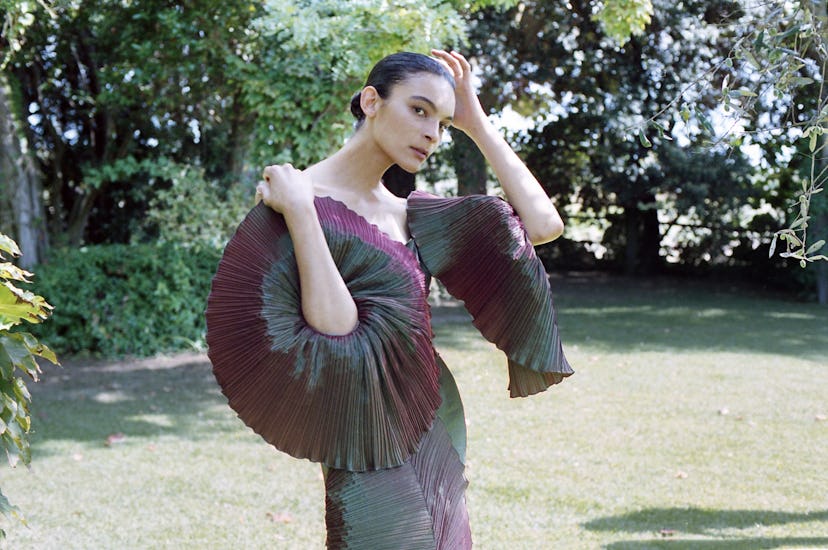Capucci Roma Captures The Spirit of The Eternal City, Mixing the “Raw” and the “Precious”

The Capucci Roma designers Luisa Orsini and Antonine Peduzzi are the first to admit that Roberto Capucci—the avant-garde couturier whose house they took creative control of earlier this year—was not for everyone.
Capucci’s legacy is one that is both classic and experimental, and, throughout, laced with humor. The Roman designer shocked the establishment with his radical approach to couture in the early 1950s (aged just 21), when he began introducing origami-inspired, fantastically sculptural gowns to the Italian, European, and soon, overseas markets.
By the 1960s, Capucci had an atelier around the corner from Coco Chanel’s on Rue Cambon in Paris. Some of his work, such as the 12 dress sculptures he made for the Venice Biennale in 1996, were quite literally unwearable. Most though, simply required a woman with equal vision to his own. He went on to dress many of Rome’s most forward-thinking figures (not to mention Jaqueline Kennedy-Onassis, Marilyn Monroe and Maria Callas).
Among those women were the family members of curator Vittoria Bonifati, whose mother Paola Santarelli, a longtime friend and client of Capucci’s, took the financial reins of his house several years ago. Bonifati and Santarelli’s family have long supported the arts (for example, they capture a long arc of Roman civilization through their formidable ancient marble collection at Villa Lontana).
Bonifati recently returned home to Rome, and has been working hand and hand with Capucci, now 89, to lend new life to the brand today.
This meant bringing in Orsini and Peduzzi, two designers and close friends who met many years ago at Villa Medici and have been collaborating ever since, working for brands such as Valentino, Louis Vuitton, as well as their own line, TL-180. Orsini and Peduzzi debuted their first collection for the brand for Fall 2019, and are translating Capucci’s singular vision for the modern world, creating a ready-to-wear line which respects the couturier’s gifts, and imagines what he might design were he beginning today.
“We like to add a touch of the haute couture,” says Orsini, at dinner in Rome this past week. “But in a contemporary way to wear it. He was more than contemporary. He was a visionary.”
This means experimenting with volume, for instance, by translating formal structured dresses into softer pleated gowns in which the wearer can play with, and shift, the volume on the neckline themselves. Another fantastic couture gown, with hand-stitched red weaving lines, is re-envisioned as a suit in an easily malleable silk jacquard cloque.
“We liked the fact that he created volume. We want to create this volume in a different way,” says Peduzzi.
“And the fabric,” continues Orsini. “For example, Capucci always worked with very raw materials and very chic and precious silk. We want to continue mixing those materials. So, for example, using a very raw silk alongside raffia.”
“He used to work a lot with arte povera,” Peduzzi explains. “Which is exactly that: You put in a museum something that is materially without high worth, but is super valuable for you. So, overall, it is valuable.”
Orsini and Peduzzi still work with the tailors Capucci grew up with in his original atelier. Those tailors pass along knowledge from decades of working on experimental couture with Capucci (and Italy’s longstanding sartorial tradition). Even within the new ready-to-wear, several of the pieces are made-to-order. And, of course, the house is still designing couture for clients; Capucci himself remains involved in this facet of the business.
“Capucci Roma represents a strong universe for a strong woman,” relates Orsini.
“It’s not only about fashion,” says Peduzzi. “It’s about knowing Capucci for all its heritage and also Capucci as someone who is really interested in art. I think you can feel it in what he used to do, and what we are trying to do. It’s not only just about putting on beautiful clothes, it’s also something with another language.”
This modern interpretation of the designer’s love of the arts, for his city, and his avant-garde vision is entirely fitting for a metropole that is now experiencing a type of new Renaissance in and of itself. That the new translation and invention is coming almost entirely from women (only the man himself and the in-house PR excluded) is rare—but equally fitting. The new Capucci, as inspired by the original, is a celebration of an artistic place and the dynamic women who power it.